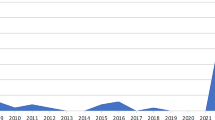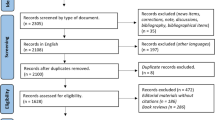Abstract
This article presents an application of a bibliometric and visual study of the research carried out on a social science subfield, concretely the consumer behaviour research (CBR), from a longitudinal perspective (period 1966–2008). The study combines performance analysis and science mapping for detecting and visualizing conceptual subdomains. Quantitative and qualitative measures are used in order to identify the most prominent themes. Quantitative data are used to put together very related concepts (themes or clusters of topics), while qualitative indicators (as those based on citations) are used to measure the quality and/or impact of the detected themes. The study also uses bibliometric maps to show in a visual way the associations between the main concepts treated by the CBR community. The maps provide insight into the structure of the CBR, visualize the division of the field into several subfields, and indicate the relationships between these subfields. Co-word analysis is the bibliometric technique used to identify the main themes. All this allows us to quantify and visualize the thematic evolution of the CBR. It also helps to both experts and novices to understand the current state of the art of the CBR and to predict where future research could lead.
Similar content being viewed by others
References
Bailón-Moreno R., Jurado-Alameda E., Ruiz-Banos R.: The scientific network of surfactants: structural analysis. J. Am. Soc. Inf. Sci. Technol. 57(7), 949–960 (2006)
Berelson B.: Content Analysis in Communications Research. Free Press, Glencoe (1952)
Bettencourt L.A., Houston M.B.: The impact of article method type and subject area on article citations and reference diversity in JM, JMR, and JCR. Mark. Lett. 12(4), 327–340 (2001)
Callon M., Courtial J.P., Laville F.: Co-word analysis as a tool for describing the network of interactions between basic and technological research—the case of polymer chemistry. Scientometrics 22(1), 155–205 (1991)
Callon M., Courtial J.P., Turner W.A., Bauin S.: From translations to problematic network—an introduction to co-word analysis. Soc. Sci. Inf. Sur Les Sci. Soc. 22(2), 191–235 (1983)
Cho C.H., Khang H.: The state of internet-related research in communications, marketing and advertising: 1994–2003. J. Advert. 35(3), 143–163 (2006)
Cobo M.J., López-Herrera A.G., Herrera-Viedma E., Herrera F.: An approach for detecting, quantifying, and visualizing the evolution of a research field: a practical application to the fuzzy sets theory field. J. Informetr. 5(1), 146–166 (2011a)
Cobo M.J., López-Herrera A.G., Herrera-Viedma E., Herrera F.: Science mapping software tools: review, analysis and cooperative study among tools. J. Am. Soc. Inf. Sci. Technol. 62(7), 1382–1402 (2011b)
Cohen J., Chakravarti D.: Consumer Psychology. Annu. Rev. Psychol. 41, 243–288 (1990)
Coulter N., Monarch I., Konda S.: Software engineering as seen through its research literature: a study in co-word analysis. J. Am. Soc. Inf. Sci. 49(13), 1206–1223 (1998)
EC3: Research Group Evaluación de la Ciencia y la Comunicación Científica: CoPalRed (v. 1.0) (Software). University of Granada, Granada. http://ec3.ugr.es/ (2006). Accessed 15 March 2011
Echchakoui, S., Mathieu, A.: Marketing trends: content analysis of the major journals (2001–2006). Proceedings of administrative sciences association of Canada, Nova Scotia, May 27–28, pp. 114–126 (2008)
Franceschini, F., Maisano, D.: Quality & Quantity journal: a bibliometric snapshot. Qual. Quant. (2010). doi:10.1007/s11135-010-9398-5
Garfield E.: Scientography: mapping the tracks of science. Curr. Contents Soc. Behav. Sci. 7(45), 5–10 (1994)
Helgeson E.A., Mager K.J., Taylor C.: Trends in consumer-behavior literature: a content analysis. J. Consumer Res. 10(4), 449–454 (1984)
Hoffman D.L., Holbrook M.B.: The intellectual structure of consumer research: a bibliometric study of author co-citations of the first 15 years of the journal of consumer research. J. Consumer Res. 19(4), 505–517 (1993)
ISI Web of Science (ISIWoS). http://scientific.thomson.com/products/wos/ (2011). Accessed 15 March 2011
Jacoby J., Johar G.V., Morrin M.: Consumer behavior: a quadrennium. Annu. Rev. Psychol. 49, 319–344 (1998)
Juvan S., Bartol T., Boh B.: Data structuring and classifications in newly-emerging scientific fields. Online Inf. Rev. 29(5), 483–498 (2005)
Kassarjian H.: Content analysis in consumer research. J. Consumer Res. 4(1), 8–18 (1977)
Katona G., Mueller E.: A study of purchase decisions. In: Clark, L.H. (eds) Consumer Behavior, New York University Press, New York (1954)
Kevork E.K., Vrechopoulos A.P.: CRM literature: Conceptual and functional insights by keyword analysis. Mark. Intell. Plan. 27(1), 48–85 (2009)
Lazarsfeld P.F., Berelenson B., Gaudet H.: The People’s Choice. Vol. 1, 2nd edn. Columbia University Press, New York (1948)
Leydesdorff L., Zhou P.: Co-word analysis using the Chinese character set. J. Am. Soc. Inf. Sci. Technol. 59(9), 1528–1530 (2008)
López-Herrera, A.G., Cobo, M.J., Herrera-Viedma, E., Herrera, F., Bailón, R., Jiménez-Contreras, E.: Visualization and evolution of the scientific structure of fuzzy sets research in Spain. Inf. Res. 14(4) paper 421 (2009)
López-Herrera A.G., Cobo M.J., Herrera-Viedma E., Herrera F.: A bibliometric study about the research based on hybridating the fuzzy logic field and the other computational intelligent techniques: a visual approach. Int. J. Hybrid Intell. Sys. 17(7), 17–32 (2010)
McCain K.W.: Mapping authors in intellectual space: population genetics in the 1980s. In: Borgman, C.L. (eds) Scholarly Communications and Bibliometrics, pp. 194–216. sage, Newbury Park (1990)
Mela G.S., Cimmino M.A., Ugolini D.: Impact assessment of oncology research in the European Union. Eur. J. Cancer 35(8), 1182–1886 (1999)
Noyons E.C.M., Moed H.F., Luwel M.: Combining mapping and citation analysis for evaluative bibliometric purposes: A bibliometric study. J. Am. Soc. Inf. Sci. 50, 115–131 (1999)
Phillips D.M., Baumgartner H., Pieters R.: Influence in the evolving citation network of the Journal of Consumer Research. In: Arnould E.J., Scott L.M. (eds.). Adv. Consumer Res. 26, 203–210 (1999)
Roznowski J.L.: A content analysis of mass media stories surrounding the consumer privacy issue 1990–2001. J. Interact. Mark. 17(2), 52–69 (2003)
Simonson I., Carmon Z., Dhar R., Drolet A., Nowlis S.M.: Consumer research: in search of identity. Annu. Rev. Psychol. 52, 249–275 (2001)
Sivadas E., Johnson M.S.: Knowledge flows in marketing: an analysis of journal article references and citations. Mark. Theory 5, 339–361 (2005)
Tellis G.J., Chandy R.K., Ackerman D.S.: In search of diversity: the record of major marketing journals. J. Mark. Res. 36(1), 120–131 (1999)
Tybout A., Artz N.: Consumer psychology. Annu. Rev. Psychol. 45, 131–169 (1994)
Val’tukh K.K.: A theoretical model of mass consumer behaviour and some methodological problems of social studies. Qual. Quant. 9(4), 323–337 (1975)
van Raan A.F.J.: Handbook of Quantitative Science and Technology Research. Chapter Measuring Science, pp. 19–50. Springer, Dordrecht (2005)
Viedma-del-Jesus, M.I., Perakakis, P., Muñoz, M.A., López-Herrera, A.G., Vila, J.: Sketching the first forty-five years of the journal Psychophysiology (1964–2008): a co-word based analysis. Psychophysiology 48, 1029–1036 (2011)
White H.D.: Author co-citation analysis: overview and defense. In: Borgman C.L. (ed.) Scholarly Communications and Bibliometrics, pp. 84–106. Sage, Newbury Park (1990)
Whittaker J.: Creativity and conformity in science: titles, keywords, and co-word analysis. Soc. Sci. Sci. 19, 473–496 (1989)
Williams B.C., Plouffe C.R.: Assessing the evolution of sales knowledge: a 20-year content analysis. Ind. Mark. Manag. 36(4), 408–419 (2007)
Yale L., Gilly M.C.: Trends in advertising research: a look at the content of marketing oriented journals from 1976 to 1985. J. Advert. 17(1), 12–22 (1988)
Zhang J., Wolfram D., Wang P., Hong Y., Gillis R.: Visualization of health-subject analysis based on query term co-occurrences. J. Am. Soc. Inf. Sci. Technol. 59(12), 1933–1947 (2008)
Author information
Authors and Affiliations
Corresponding author
Rights and permissions
About this article
Cite this article
Muñoz-Leiva, F., Viedma-del-Jesús, M.I., Sánchez-Fernández, J. et al. An application of co-word analysis and bibliometric maps for detecting the most highlighting themes in the consumer behaviour research from a longitudinal perspective. Qual Quant 46, 1077–1095 (2012). https://doi.org/10.1007/s11135-011-9565-3
Published:
Issue Date:
DOI: https://doi.org/10.1007/s11135-011-9565-3




